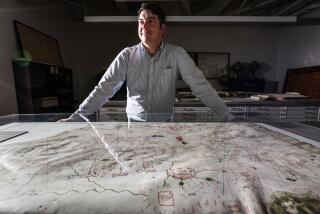Firm Brings Mapping Power to the Desktop : Software By MapInfo Expands PC Boundaries
- Share via
TROY, N.Y. — Long after explorers charted their course by stars or compass, a computer software pioneer has literally mapped out a product and a business strategy that is guiding his company to success.
The 3-year-old company is MapInfo Corp., which sells a software package that allows the personal computer user to merge databases and digital maps of areas within the United States.
With a couple of keystrokes, the user can place the cursor at a point on a map displayed on the computer screen and have access to volumes of information.
MapInfo can search a database for points within a boundary, determine latitude and longitude of a point or find an address. Users can focus in on a 52-foot span of a city block or zoom out to a 5,000-mile range. That may not sound like anything new, says MapInfo President Sean O’Sullivan with a smile, but his young company claims to be No.1 in desktop mapping. In fact, he says, there isn’t even any competition--yet.
Complements Other Methods
“These kinds of capabilities have been available on minicomputers and mainframes before, but it’s never been made so that the common person can use it or it’s never been priced so that the common person can afford it,” said O’Sullivan, who developed the firm with three other students of Rensselaer Polytechnic Institute in 1985.
While some might view MapInfo’s product as competition for mapping via larger computers, it can also complement those methods, says Thomas Delaney, manager in IBM’s geographic and mapping products department in Kingston, N.Y.
IBM is on MapInfo’s list of customers, and is also a competitor.
“The market is not really a market where if you do PC stuff, you’re going to influence mainframes. It really all has to work together,” he said.
Delaney refused to say if IBM, which now is involved in mapping using mainframes and minicomputers, is developing a program that would be comparable to MapInfo’s.
So just who uses digital maps and databases on personal computers?
Companies or individuals use MapInfo for sales and marketing, trend analysis, demographic analysis, dispatching and even planning of routes for optical fiber cables.
More Affordable
Customers include police departments who want to map out crime scenes, real estate agents, city planners, cemetery planners, orange growers and scientists tracking insect populations or AIDS concentrations.
“Even if the job is really large . . . and they’ve (clients) got their heart set on a larger system, we would recommend MapInfo to start out with and to train their people, if nothing else,” said Mickey Talton, vice president of CAPS Consulting, which works with the growing market of geographical information systems.
Based in Tuscaloosa, Ala., CAPS Consulting deals primarily with urban planning departments and recommends MapInfo frequently because of its quality, speed with large databases, ease of use and price, he said.
“Smaller cities and smaller government entities can afford to have this in their offices,” he said.
O’Sullivan said sales went from zero to millions within one year, but he refuses to disclose figures.
Their customers, which are located in 18 countries, include the U.S. Postal Service, United Parcel Service, the U.S. Geological Survey, American Telephone & Telegraph Co. and Chrysler Corp.
This spring, MapInfo won a $250,000 contract with the U.S. Army to provide mapping software to its recruiting command. The system will be used for sales and marketing applications to help the Army better allocate recruiting personnel.
“There’s a potential (for MapInfo) to be a $50- (million) to a $100-million dollar company down the road,” O’Sullivan said.
MapInfo came to be when O’Sullivan completed the design of an electronic map and tracking system for automobiles as part of a college project. By the time Sullivan graduated in 1985, he and three other engineers and programmers had joined with business consultant Michael Marvin and obtained financial backing to launch the firm.
The first digital mapping system was unveiled in 1987, the current version in January, 1988. The software package costs $750 and digital maps for 300 metropolitan areas in the United States range in price up to $2,000.
The programs provide names of streets, rivers and bridges, as well as address number ranges for every block and side of a street.




